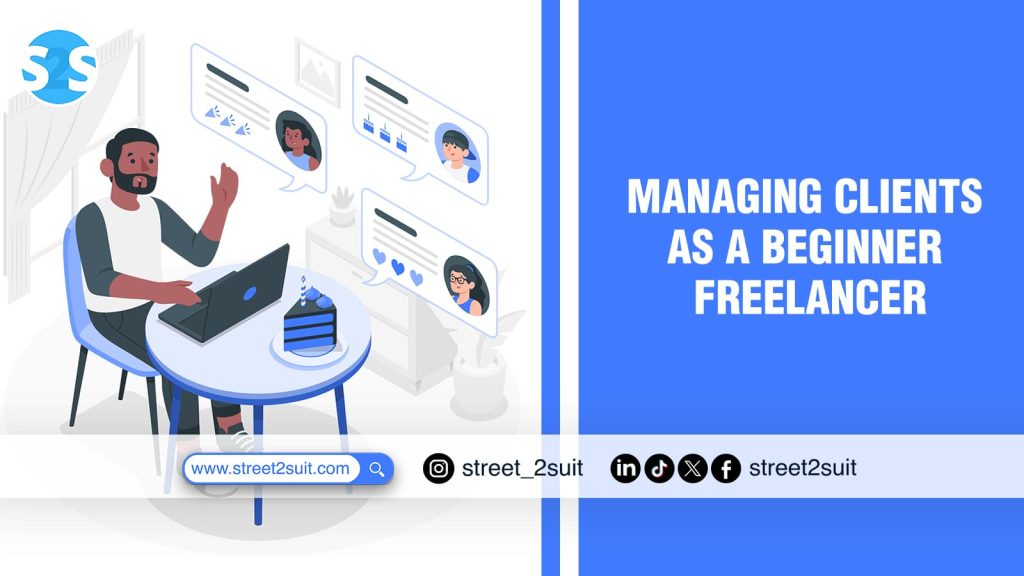…because being underpaid and overwhelmed shouldn’t be part of your job description.
You’ve just stepped into the vibrant, chaotic, and wildly rewarding world of freelancing.
Welcome!
I now refer to you as your own boss, secretary, marketing team, accountant, therapist, and—if you’re unlucky—your own unpaid intern. But amidst all the freedom and flexibility, there’s one challenge you’ll need to tackle early on: managing clients.
More specifically, managing clients without letting them drive you up the wall.
As a beginner freelancer, you may be tempted to bend over backward to keep clients happy. You want 5-star reviews, referrals, and recurring gigs—totally normal. But let’s be honest: saying “yes” to everything, working without boundaries, and sending deliverables at midnight like an MTN network asking one to subscribe to one thing or the other isn’t sustainable.
Here’s a practical guide to managing clients as a beginner freelancer—and doing it like the star you are (even if your Wi-Fi is still blinking red, or area transformer blew).
1. Start With Boundaries, Not Burnout
You might think, saying “I’m available anytime!” makes you look committed. Spoiler: it makes you look desperate. And desperation is the perfume that attracts every red-flag client on the planet.
- Set boundaries from day one.
- Define your working hours.
- Clarify how clients can reach you (email? project platform? Not midnight WhatsApp calls, please).
- Communicate clearly when you’ll be offline (weekends, public holidays, or when your brain needs a reboot).
Client: “Can you hop on a quick call at 10 PM?”
You: “Absolutely! Right after I finish filing… Yeah, that imaginery filing.”
Learn this early: boundaries are not rude—they’re professional. They protect your peace, your time, and your battery life.
2. Crystal-Clear Communication Is Your Freelancing Superpower
The greatest tragedies in freelancing are caused not by low pay or late nights, but by poor communication.
Clients can’t read minds. Not even the ones who say, “Just do what you feel is best.”
As a beginner, this means:
- Clarifying expectations before you start.
- Breaking down your deliverables.
- Getting agreement on the timeline, format, payment, and revision policies (yes, even for cousin Emeka).
- Send regular updates. Recap calls with emails. Confirm instructions. Repeat things in writing.
And remember: if it’s not documented, it didn’t happen.
3. Contracts Are Not Just for Big Shots in Suits
You may think, “I’m just starting. A contract sounds too formal. I mean… we met on Facebook!”
Listen, whether it’s a multinational brand or Auntie Ngozi’s side hustle, get. it. in. writing.
Contracts protect both of you. They define:
- Scope of work
- Deliverables
- Payment terms (upfront, milestone, or post-delivery)
- Deadlines
- Revisions allowed
- Late payment fees (yes, you can include that!)
You don’t need a law degree—templates online will do. Just tweak it to suit your service.
You wouldn’t board a plane without knowing where it’s landing. So don’t start a project without clarity either.
4. The Art of Saying No (Without Sounding Like a Villain)
Here’s a truth bomb: Not every client is your client. Not every task is your task.
As a beginner, you might feel guilty turning down work. But saying yes to everything:
- Dilutes your focus
- Delays your growth
- Invites stress faster than a Lagos traffic jam
Client: “Can you also design a logo, manage our socials, write 50 blog posts, and be available 24/7?”
You: “Thank you for thinking I’m capable of all. But no.”
Declining respectfully shows you value your time and know your strengths. And guess what? Clients respect freelancers who respect themselves.
5. Use Tools So You Don’t Look Lost
Don’t manage your entire business in your head. That’s how deadlines slip, files go missing, and clients start calling you “unprofessional.”
Leverage free or affordable tools:
- Trello / Notion / ClickUp – for task management
- Google Docs / Drive – for collaboration and file sharing
- Canva – for basic designs
- Grammarly – for polished writing
- Paystack / Wave / PayPal – for invoicing
- Calendly – for scheduling meetings (bye-bye, back-and-forth emails)
Using tools helps you look organized and dependable. And trust me, clients love that—even the chaotic ones.
6. Handle Revisions with Class, Not Chaos
There are two types of revision requests:
1. Reasonable ones (like fixing a typo)
2. Possessive client meltdowns (e.g., “Can you make the sunset brighter and more emotionally relatable?”)
As a beginner, you need to:
- State your revision policy upfront (e.g., two free revisions, charges thereafter).
- Document feedback and reference it when needed.
- Stay polite, but stand your ground when requests go beyond the scope.
Sometimes, the key to revision sanity is simply reminding the client what they initially approved (with screenshots, if needed).
7. Don’t Chase Clients—Chase Structure
Waiting for a client to respond for days? Been there, done that. Instead of chasing clients, focus on creating systems that keep your business flowing smoothly. Set expectations for response times and follow up if you haven’t heard back after a designated period.
Establishing structure will save you from the rollercoaster of client unpredictability. You’re a professional, not a detective; invest your time in the projects that matter.
Conclusion
Managing clients is part skill, part courage, and part humor (with a sprinkle of prayer). Every freelancer has a “What was I thinking?” moment, but those moments help shape you.
As a beginner freelancer trying to navigate it all, don’t suffer in silence—connect with others, join a community, and keep learning.
This guide should help you navigate the client landscape as a beginner freelancer while maintaining your sanity and professionalism. Happy freelancing!
Receive the latest job and career updates in your inbox, every week!




